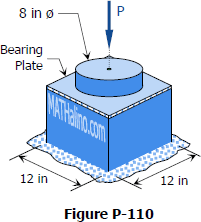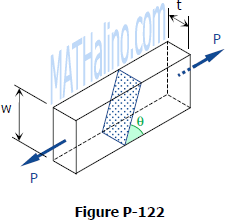04-05 Stiffness and strength of timber beam
Problem 4
The stiffness of a rectangular beam is proportional to the breadth and the cube of the depth. Find the shape of the stiffest beam that can be cut from a log of a given size.
- Read more about 04-05 Stiffness and strength of timber beam
- Log in to post comments
Solution to Problem 581 | Design for Flexure and Shear
Problem 581
A laminated beam is composed of five planks, each 6 in. by 2 in., glued together to form a section 6 in. wide by 10 in. high. The allowable shear stress in the glue is 90 psi, the allowable shear stress in the wood is 120 psi, and the allowable flexural stress in the wood is 1200 psi. Determine the maximum uniformly distributed load that can be carried by the beam on a 6-ft simple span.
Solution to Problem 572 | Horizontal Shearing Stress
Problem 572
The T section shown in Fig. P-572 is the cross-section of a beam formed by joining two rectangular pieces of wood together. The beam is subjected to a maximum shearing force of 60 kN. Show that the NA is 34 mm from the top and the INA = 10.57 × 106 mm4. Using these values, determine the shearing stress (a) at the neutral axis and (b) at the junction between the two pieces of wood.
18 - 20 Rectangular beam in maxima and minima problems
Problem 18
The strength of a rectangular beam is proportional to the breadth and the square of the depth. Find the shape of the largest beam that can be cut from a log of given size.
Solution to Problem 527 | Flexure Formula
Problem 527
In Prob. 526, if the load on the overhang is 600 lb/ft and the overhang is x ft long, find the maximum values of P and x that can be used simultaneously.

- Read more about Solution to Problem 527 | Flexure Formula
- Log in to post comments
Solution to Problem 526 | Flexure Formula
Problem 526
A wood beam 6 in wide by 12 in deep is loaded as shown in Fig. P-526. If the maximum flexural stress is 1200 psi, find the maximum values of wo and P which can be applied simultaneously?

- Read more about Solution to Problem 526 | Flexure Formula
- Log in to post comments
Solution to Problem 129 Bearing Stress
Problem 129
- Read more about Solution to Problem 129 Bearing Stress
- Log in to post comments
Solution to Problem 123 Shear Stress
Problem 123
A rectangular piece of wood, 50 mm by 100 mm in cross section, is used as a compression block shown in Fig. P-123. Determine the axial force P that can be safely applied to the block if the compressive stress in wood is limited to 20 MN/m2 and the shearing stress parallel to the grain is limited to 5MN/m2. The grain makes an angle of 20° with the horizontal, as shown. (Hint: Use the results in Problem 122.)
- Read more about Solution to Problem 123 Shear Stress
- 1 comment
- Log in to post comments
Solution to Problem 110 Normal Stress
Problem 110
 A 12-inches square steel bearing plate lies between an 8-inches diameter wooden post and a concrete footing as shown in Fig. P-110. Determine the maximum value of the load P if the stress in wood is limited to 1800 psi and that in concrete to 650 psi.
A 12-inches square steel bearing plate lies between an 8-inches diameter wooden post and a concrete footing as shown in Fig. P-110. Determine the maximum value of the load P if the stress in wood is limited to 1800 psi and that in concrete to 650 psi.
- Read more about Solution to Problem 110 Normal Stress
- Log in to post comments

